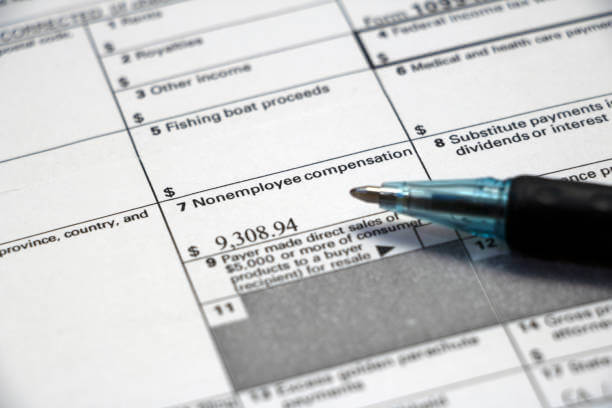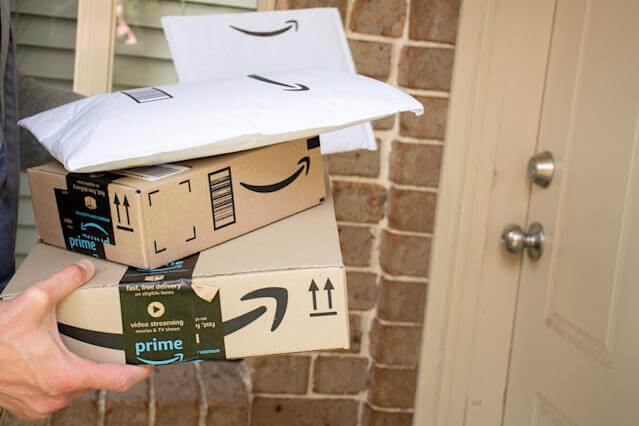The ride-hailing app and online food/retail-ordering delivery industries have skyrocketed into popularity since Uber first launched its app in 2009. It is estimated that there are currently up to 1.5 million individuals driving for Uber and Lyft, as well as approximately one million 1099 DoorDashers and over half a million Postmates 1099 delivery drivers. And while there are no official numbers on the Amazon Flex 1099 fleet, we know that it's part of Amazon's 5-billion-Prime-items-per year delivery logistics team -- which is to say: it's sizeable (and growing!)
Now, an Amazon Flex driver's life is busy and complicated enough -- so, having to do self-employment taxes can add significant strain to an already stressful job, thanks to confusing and ever-changing IRS rules and forms.
So, if you drive for Amazon Flex and are unclear about your taxpayer status or responsibilities -- and how the 1099 form figures into it all -- the following information should answer a few questions for you, as well as offer a simple and affordable way to get a handle on your business accounting and tax bookkeeping with the Bonsai Tax app.
Note: Bonsai Tax can help you cut out all the paperwork and will auto-fill the appropriate tax forms with accurate calculations when it's time to file a tax return for the year. Claim your 7-day free trial here.
Driving For Amazon Flex: The Basics
With the astonishing success of Uber, Lyft, DoorDash, Postmates (owned by Uber since 2020), and other home delivery services, the mega-retailer (and online-order delivery service pioneer) Amazon joined the snowballing independent-driver-operated logistics game in 2015 with its own version: Amazon Flex.
It is crucial for Amazon Flex contractors to keep track of their income as well as their business expenses (for tax write-offs) -- because, unlike W2 salaried employees, self-employed taxpayers are wholly responsible for knowing how much they owe to the IRS.

How Do You File A Tax Return As An Amazon Flex Delivery Driver?
Amazon Flex drivers can expect to receive a 1099 form from the Amazon company if they earned at least $600 working for the service within the tax year.
Let's take a closer look at what this means.
1099 Forms You'll Receive As An Amazon Flex Driver
A 1099 form is a series of documents the IRS calls an "information return", defined as a tax return that contains taxpayer's identifying information but does not state their tax liability. In other words, it's a form that is filled out for information purposes that specifies the earnings made from a given contract but does not calculate the tax debt on any of it.
A 1099 form is filled out by a client or employer doing business with a freelancer/independent contractor -- and a copy is sent to both, the contractor and the IRS. 1099 forms come in a variety of versions, designed for different types of non-salary income. Some are issued for earnings as low as $10 in earned interest, but the majority start at $600 income earned from a single client within the tax year.
Here are some of the most frequently-received 1099 forms received by Amazon drivers:
- Form 1099-NEC. This is the "non-employee compensation" 1099 form you receive from Amazon Flex if you earn at least $600 with them (if it is under $600, you will not receive the form -- but still have to report the income otherwise you'll receive filing penalties).
- Form 1099-K. The K forms exist to account for virtual sales transactions made through third-party platforms like PayPal
Getting Your 1099 From Amazon Flex
When you sign up as a driver for Lyft, DoorDash, or Amazon Flex, you need to fill out a W-9 form which provides the company with your information, so that they can issue you a 1099.
If you earn at $600 per tax year driving for Amazon Flex, expect a 1099-NEC form in the mail from them by late January/early February of the following year (the official deadline for a client to file the 1099 form is January 31st).
Make sure they have your most recent address so that the form does not get lost in the mail (though, even if it does, it is not a big deal -- you can still report your income without a 1099 on Schedule C anyway).

Do You Have To Pay Taxes On All Amazon Flex Income?
American taxpayers are legally required to pay taxes on all income, period! This means that you need to pay income on all earnings made from being an Amazon Flex driver, regardless of how much it was.
Now, you are supposed to receive a 1099-NEC from Amazon Flex, but if, for whatever reason, it does not make it into your mailbox, you are still required to report that income on Schedule C of IRS form 1040 (which is the tax return you file by April 15th for the previous tax year).
Schedule C serves as a hub for reporting all independent contractor income and expenses, accounting for your "Profit or Loss from Business".
Remember: you only receive 1099s once you're crossed a certain earnings quota (typically $600) from a client or a company -- but you still need to report all income to the IRS -- even the lower sums that do not warrant an issuance of a 1099 -- on Schedule C.
Penalties For Under-Reporting/Mis-Reporting Income To The IRS
It is recommended to report all 1099 income to the IRS, as, chances are, the IRS received a copy from your client/employer and, now that their software "red-flagged" your account for something "fishy". The IRS will catch a missing 1099 and they will be getting in touch to clarify any discrepancies they find.
Needless to say, the IRS penalizes such offenders with charging fines -- and interest! -- on the tax liability they determine. You may have to pay 50-200% penalty on the tax liability for the portion of the income originally omitted, with the amount of penalty depending on whether the IRS finds it to be a case of income "under-reporting" (due to unintended negligence) or income "mis-reporting" (due to fraudulent intentions).

Filing/Paying Self-Employment Taxes
Amazon Flex Drivers are considered "1099 non-employee workers", which is a separate taxpayer status from the classic W-2 salaried employees who work for someone else.
Taxes For 1099 Workers vs. W2 Employees
The W2 employees typically do not have to worry about paying taxes on time: this is taken care of them on behalf of their employer who withholds estimated taxes from every paycheck throughout the year (any overpayment is refunded after they file a tax return).
The self-employed -- such as independent drivers for ride-hailing and food/retail delivery -- pay taxes differently. They are expected to estimate their salary for the ongoing tax year and need to pay quarterly estimated taxes every three months -- plus file a tax return.
Self-employed app-based contractors like Amazon Flex drivers are responsible for paying the following taxes:
- Federal Income Tax -- applies to anyone who earned any income in the U.S. (look up your marginal tax brackets as they apply to your salary range in 2021)
- State Income Tax -- where applicable (some U.S. states levy flat-rate income tax, some graduated-rate income tax, and some none at all)
- Self-Employment Tax -- essentially a Social Security/Medicaid tax for the self-employed (for the year 2021, the self-employment tax is set at 15.3% -- and it is applied to 92.35% of your total income from self-employment)
In fact, you can use this free tool to calculate your 1099 taxes and see how much you owe at the end of the year.

Paying Quarterly Taxes
The U.S. taxation system is set up on a "pay-as-you-go" model, which means that anyone with an income is expected to pay taxes on earnings as they come in. As mentioned, the W-2 employees achieve this by instructing their employers (in a W-4 form) on what percentage of their earnings to withhold from every paycheck.
Self-employed workers such as Amazon Flex 1099 drivers, on the other hand, are held to a different system: the quarterly estimated tax payments they have to send in on their own.
To avoid being penalized, the self-employed taxpayer must:
- Make sure that the estimated taxes are not underpaid, which incurs a fine (it is always best to err on the side of caution and overpay a little, as there is no quarterly tax penalty for that -- and it will be refunded to you eventually).
- Send in each quarterly estimated tax payment on schedule, by the IRS-specified quarterly deadline (not honoring the deadlines and paying estimated taxes late also incurs financial penalties).
Quarterly Tax Estimate Due Dates for 2021
The following are the deadlines for each quarterly estimated tax payment:
- January 1 to March 31: to be paid by April 15, 2021
- April 1 to May 31: to be paid by June 15, 2021
- June 1 to August 31: to be paid by September 15, 2021
- September 1 to December 31: to be paid by January 18, 2022 (keep in mind: if you file your 2021 taxes by January 31, 2022, and cover the entire balance due with your tax return, you may skip paying this fourth installment)
How Much To Put Away For Quarterly Taxes
The general rule of thumb is to put away 30-35% of your Adjusted Gross Income (income reduced by tax write-offs) for taxes. Once you calculate what that percentage is for the tax year, divide that number by 4 -- and you have your quarterly estimated tax payments.
Of course, you can also let the smart accounting Bonsai Tax app calculate your quarterly estimated taxes for you, based on the income and expenses data enrolled in your bookkeeping account -- under its 100% accuracy guarantee. Try a free trial here.

Which Expenses Are Deductible For Amazon Flex Drivers?
Driving for Amazon Flex, some of your expenses are eligible to be written off as self-employed tax deductions from your income.
A tax deduction is a reduction of income to be taxed, most frequently as a result of "writing off" business expenses that were made to directly benefit one's business.
The earlier-mentioned Adjusted Gross Income (AGI) is the taxable income after you have subtracted all the qualifying deductions. Obviously, the lower you can bring your AGI, the less money you must pay for it in taxes. Conversely, the fewer taxes you pay, the more money you are left with to reinvest into your enterprise.
For this reason, it is very important to hold on to all your expense receipts as well as keeping records for miles a regular habit
Note: the Bonsai Tax app can scan your receipts, the mileage tracking, organizing, and maximizing of all your potential write-offs for you. On average, users save $5,600 on their tax bills at the end of the year. Claim your free trial here.
Here are the most common business expenses Amazon Flex drivers can claim as deductions to lower their AGI:
- Gas/Mileage Expenses. Amazon Flex drivers can deduct "business miles" spent driving while making deliveries. The business miles only count during times you are actively delivering packages to customers: miles commuted between home and Amazon delivery station or home and local stores are not eligible for a write-off. Amazon Flex drivers are free to use either the "standard mileage" or "actual expense" methods to calculate the deduction.
- Cellular phone costs. Estimate the percentage of time you use your phone for business purposes and deduct the percentage cost of the phone bill.
- Parking/Toll Fees. The costs of parking or road tolls while making deliveries for Amazon Flex qualify as deductions.
The more business expense receipts you save, the more deductions you may be able to claim: depending on how much driving you do, those costs can add up to a pretty penny -- so don't neglect to write them off!

Want To Go Easier On Yourself? Get Bonsai Tax
If the topic of taxes gives you a major case of the heebie-jeebies, first -- take a deep breath, second -- remember that you have options to dramatically simplify the process with modern, smart digital accounting tools -- tools like Bonsai Tax: a bookkeeping app designed specifically for the tax needs of freelancers like Amazon Flex delivery drivers.
Let Bonsai Tax Handle Your Amazon Flex 1099 Forms And All Other Self-Employed Taxes
With the Bonsai Tax app in your corner, all you really have to do is answer some preliminary questions to get the account started -- and then to simply maintain enrolling information that cannot be automated (like scanning in cash receipts for business expenses, since the software cannot possibly know about such transactions on its own...) The rest, is taken care of by the software, which:
- Records your income
- Scans, sorts, and tracks business expense receipts for maximized tax write-offs
- Auto-imports your bank and credit card expenses into your account on an ongoing basis
- Calculates Quarterly Tax Estimates on the basis of the already-enrolled information and keeps you on-schedule with payments.
- Generates on-demand "profit and loss" statements for your business, so that you always have a clear picture of your budget
- Makes filing tax returns a breeze by auto-filling the bulk of the "paperwork"
- Is a secure, fully cloud-based software. This means there is no need to download anything: simply sign into your online account from any device with an internet access.
At the end of the day, the Bonsai Tax App achieves two key functions for the Amazon Flex contractor:
- Takes care of and automates the most complicated aspects of self-employed tax bookkeeping: knowing which IRS forms to fill out, sorting deductibles into appropriate categories, and taking care of all the cumbersome calculations.
- Makes you more knowledgeable, more confident, and generally better at doing taxes: the user-friendliness and transparency of the program teaches you to understand what you are doing, growing more comfortable with the entire process as you go.
Sign up for the 7-day free trial with Bonsai Tax -- and save your time, focus, and nerves for doing your best driving!
Related Reading:
- 1099 Late Filing Penalty
- How Much Should I Set Aside for Taxes 1099?
- Twitch 1099
- Ebay 1099
- Amazon Flex 1099






